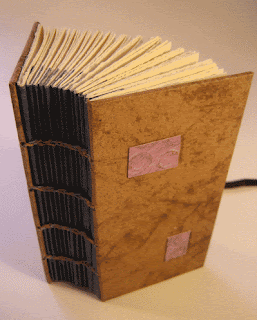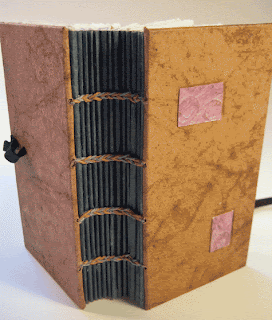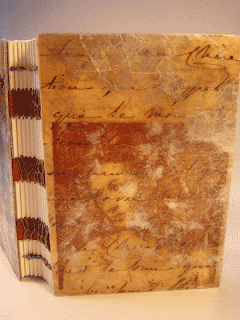 I've been moving -- slowly, I know -- through the products of my BookWorks class with Dan Essig. On the fourth day (this series is beginning to sound like an installment from Genesis) our focus was a concertina binding. Think of it as one, long continuous spine-guard that covers the spine-edge of each signature. The concertina adds particular strength to the binding. Folding the concertina EXACTLY is one of the challenges of making this book. In the photo to the right you can see the folds of the concertina between each signature.
I've been moving -- slowly, I know -- through the products of my BookWorks class with Dan Essig. On the fourth day (this series is beginning to sound like an installment from Genesis) our focus was a concertina binding. Think of it as one, long continuous spine-guard that covers the spine-edge of each signature. The concertina adds particular strength to the binding. Folding the concertina EXACTLY is one of the challenges of making this book. In the photo to the right you can see the folds of the concertina between each signature.
It's not an easy binding to stitch, since you're trailing the concertina while you're attaching each signature, but it gets easier with practice (and, of course, as you keep attaching signatures, the remaining amount of concertina lessens). We used a coptic stitch with bent needles. Dan doesn't like curved needles, but straight needles don't do the job, so we softened the metal of our needles over a candle flame and bent the ends at a 45% angle with pliers. Personally, I love curved needles for coptic bindings.
The cover was attached in a style very similar to the one we used for the papyrus book on Day Two. With this fourth book, when we covered the front and back cover-boards with paper, we left a "flap" on each cover on the spine side. We sewed through the inside fold of each flap, treating the cover like another signature. We used Cave paper for our covers, so it was strong enough to withstand being sewn through. If you were using a lighter-weight paper, you'd want to reinforce the area with a material such as Tyvek, which is strong and thin.
We also practiced making insets in the cover (indentations made by lifting layers of board with an exacto knife before we covered the boards). I adhered leftover bits of paper I'd painted and used for signatures in an earlier book.

 Dan's primer on concertina-folding
Dan's primer on concertina-folding
 We had great fun, but worked pretty intensely too.
We had great fun, but worked pretty intensely too.
 I was a big fan of The X-Files when it went on the air in 1993. I'm not a fan of science fiction, but I appreciated the premise -- rare for a tv show -- that the two main characters, a man and a woman, could work together as equals without the usual "will they or won't they" love-interest storyline. Credit Chris Carter, the show's creator and main writer, for that. Dana Scully (played by Gillian Anderson), probably the more complex of the two leads, was smart, strong, ambitious, independent, reserved, and caring. She and her partner, Fox Mulder (David Duchovny), treated each other with respect, and as they continued to work together, they developed a strong sense of loyalty to each other (and, granted, you did hope that they would get together).
I was a big fan of The X-Files when it went on the air in 1993. I'm not a fan of science fiction, but I appreciated the premise -- rare for a tv show -- that the two main characters, a man and a woman, could work together as equals without the usual "will they or won't they" love-interest storyline. Credit Chris Carter, the show's creator and main writer, for that. Dana Scully (played by Gillian Anderson), probably the more complex of the two leads, was smart, strong, ambitious, independent, reserved, and caring. She and her partner, Fox Mulder (David Duchovny), treated each other with respect, and as they continued to work together, they developed a strong sense of loyalty to each other (and, granted, you did hope that they would get together).
I was less interested in the running story about a government conspiracy and an alien settlement on earth than I was in the individual stories and how Mulder and Scully dealt with the situations and with each other. I stopped watching about four years into the show, after I moved to a new city and gave up my VCR. The show ran for nine seasons, and Time magazine named it among the 100 best television shows of all-time.
I also liked that Mulder was the "believer" and Scully the skeptic. She was a medical doctor and grounded in science; Mulder was a criminal profiler and went on intuition. This, too, played counter to the usual boy-girl scenarios and stereotypes. When Scully became convinced that Mulder was right, we, as her surrogates, believed it too.
A couple of months ago I discovered that the SciFi Channel was re-running the series. I started Tivo-ing the episodes I hadn't seen, and stacking them up for later viewing. Every once in a while I watch one, and it's a treat. Most episodes were very dark, but once in a while Chris Carter, with a big wink, would throw in a comic episode: Mulder and Scully spend Christmas Eve in a haunted house with ghosts; an obnoxious guy takes over Mulder's body and comes on to Scully, and "Mulder" plays the De Niro "you talkin to me?" scene from Taxi Driver in front of his mirror.
All in all, for a show about aliens, conspiracies, and UFOs, it was remarkably grown-up.
 I've been moving -- slowly, I know -- through the products of my BookWorks class with Dan Essig. On the fourth day (this series is beginning to sound like an installment from Genesis) our focus was a concertina binding. Think of it as one, long continuous spine-guard that covers the spine-edge of each signature. The concertina adds particular strength to the binding. Folding the concertina EXACTLY is one of the challenges of making this book. In the photo to the right you can see the folds of the concertina between each signature.
I've been moving -- slowly, I know -- through the products of my BookWorks class with Dan Essig. On the fourth day (this series is beginning to sound like an installment from Genesis) our focus was a concertina binding. Think of it as one, long continuous spine-guard that covers the spine-edge of each signature. The concertina adds particular strength to the binding. Folding the concertina EXACTLY is one of the challenges of making this book. In the photo to the right you can see the folds of the concertina between each signature.






